
An explanatory article on motorcycle engine basics, trivia and historic masterpieces
The engine is the pivot of a motorcycle. The engine characterizes motorcycles and gives motorcyclists fun and excitement. Four-stroke debuted in 1960’s, the development of DOHC accelerated in 1970’s, and innovative engines arose one after another in 1980’s. The evolutional history of the engine reflects manufacturers’ philosophies responding to the demands from the users.
This article explains all on the motorcycle engines including the history of motorcycle engines, the engine basic structures such as ‘DOHC’, ‘OHV’, ‘four-stroke’ and ‘two-stroke,’ and the historic masterpieces.
First on engine basics, let’s learn ‘valve forms’ and ‘stroke’
The personality of an engine changes by the valve configuration
The valve forms have radically changed for the pursuit of high rotations and outputs. In 1970’s, SV was eliminated, the valve configuration rapidly evolved from OHV to DOHC.
SV (side valve)
Intake and exhaust valves are arrayed at the sides of a piston. The combustion chamber is large where high compression does not lead to high rotations, and at present this valve configuration is almost eradicated.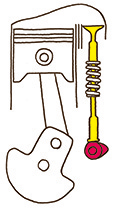
OHC (overhead camshaft)
A cam is located above the valves to dissolve ‘pushrod dances’ at high rotation. The valve configuration contains only a cam and is also called SOHC (single overhead camshaft.)
OHV (overhead valve)
This aims at the improvement of intake and exhaust efficiency, and the miniaturization of combustion chamber (high compression.) Valves are located above the piston, and opened and closed by pushrods.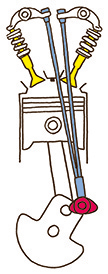
DOHC (double overhead camshaft)
This attempts to realize higher rotations than OHC, and independent cams open and close intake and exhaust valves respectively. There are also sub-classifications, direct push-on-valve and rocker arm types.
The explosion arises by two rotations of the crank in four-stroke and by one rotation of the crank in two-stroke
In four-stroke engines, a piston move generates intake, compression, explosion and exhaust individually. An explosion rises in two crank motions, i.e. four piston motions. On the other hand, in two-stroke engines, an upward motion by the piston makes intake and compression, and a downward motion causes explosion and exhaust. Then, an explosion occurs in a crank motion (i.e. two piston motions.)
Four-stroke
(1)A downward motion of the piston opens the intake valve where air-fuel mixture is drawn in.
(2)An upward motion compresses air-fuel mixture.
(3)Air-fuel mixture is ignited at the plug and the explosion brings down the piston.
(4)The piston moves up and emits exhaust gas.
Two-stroke
(1)Air-fuel mixture is drawn into the crankcase by an upward motion of the piston, and compressed and ignited.
(2)Explosion forces the piston down and compresses air-fuel mixture, and intake and exhaust occur simultaneously in transfer ports.
Three major trivia on the motorcycle engine
No. 1 “All major engine configurations had appeared until early 1980’s.”
Almost all engines appeared such as the parallel four-cylinder engine which is the mainstream now, the parallel six-cylinder and vertical four-cylinder engines from 1970’s to 1980’s, and the flat-four (subsequently, flat-six) engine employed in Honda’s Gold Wing. In those times, some challenging attempts were seen, e.g. rotary engine and turbo engine motorcycles.
SUZUKI RE-5(1974)
This is the only motorcycle equipped with rotary engine and made by Japanese manufacturer (an exported bike.) The engine displacement is 497cc.
Honda CBX(1978)
The first Japanese-made six-cylinder motorcycle appeared a year earlier than Z1300 and was equipped with air-cooled DOHC4 valves.
KAWASAKI Z1300(1979)
Kawasaki’s first six-cylinder engine had DOHC valves and realized 120ps of the maximum horsepower. The water-cooled engine was also the manufacturer’s first attempt. The long-stroke was employed to narrow the engine width.
Honda CX500 TURBO(1981)
Yamaha released a turbo engine motorcycle in the same year, and Suzuki and Kawasaki followed in 1982 and 1984. They were not granted the certificate of conformity for the domestic sale and ended up to be short-lived.
Honda VF750 SABRE(1982)
The motorcycle was first equipped with the water-cooled vertical four-cylinder engine in the world. The application of a hydraulic clutch was also the world’s first attempt.
No.2 “The foundations of various structures were established in1980’s!?”
Japanese motorcycle manufacturers clearly reflected their colors into the engines in 1980’s and established a variety of technologies leading to the modern four-cylinder engines. Among them, Yamaha’s forward-inclined engine and Kawasaki’s side cam chain are widely employed in present-day motorcycles.
[SUZUKI] Engine oil cools the cylinder heads
1985’s GSX R750 employed oil-cooling engine where oil jets blow thermal boundary layers for more cooling power. The oil-cooling is lighter and smaller than the water-cooling engine and has the higher rate of cooling, which copes with the high performance.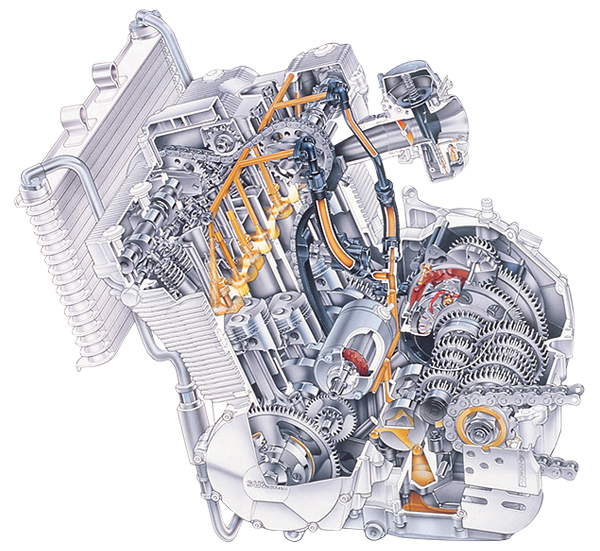
[Honda] V4 engine utilizing the technologies gained through NR
The manufacturer changed the main engine configuration of its racer and replica motorcycles (NB: ‘replica’ means race motorcycle or race replica) to V4. A variety of technologies, the gear cam drive, the back-torque limiter, etc. were fed back from NR (new racing) series.

[KAWASAKI] The first side cam chain of transverse in-line four-cylinder engines
1984’s GPZ900R employed the side cam chains, which narrows the width of the engine and is effective for the straight structure of intake and exhaust system and cooling. Today’s in-line-fours of supersport motorcycles all take this configuration.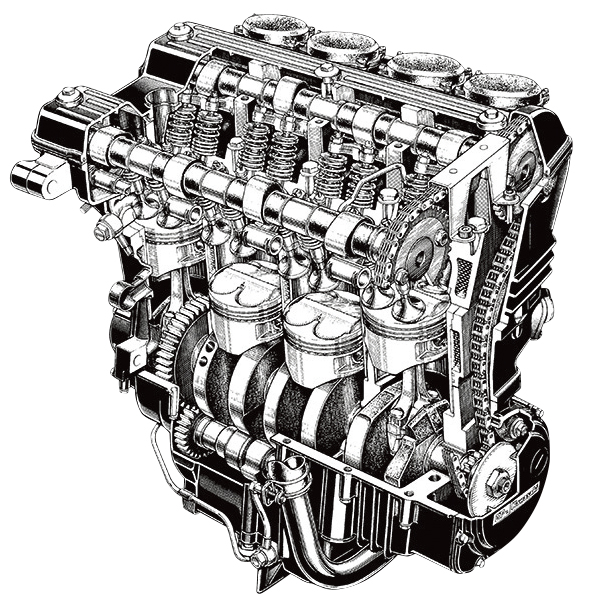
[YAMAHA] Straight ports improve air-intake efficiency
1985’s FZ750 inclined its cylinders forward at 45 degree and connected the airbox to the intake port straight through the down-draft carburetor, which improves air-intake efficiency and contributes to a low center of gravity.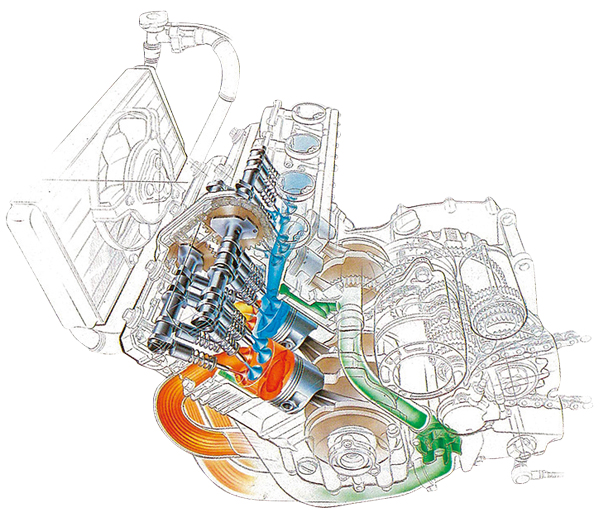
No.3 “Non-Japanese manufacturers evolve with ripeness rather than changes”
Non-Japanese manufacturers tend to use their original engine layouts for long. For example, there exist common engine parts found in its nascent and present motorcycles in Moto Guzzi. Their machine development postures are to refine them every year for improving engine performance, which show the strengths of their identities.
[DUCATI] 90-degree L-twin
The L-twin continuously evolved from 1969’s air-cooled 500cc to subsequently water-cooled and four-valve. The manufacturer radically changed its basic engine layout in Panigale series (2011~).
[HARLEY-DAVIDSON] 45-degree V-twin
The air-cooled V-twin born in 1909 has maintained its unique firing interval and sound.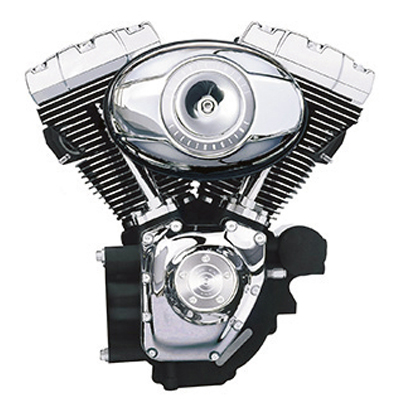
[BMW] Horizontally opposed twin (boxer twin)
The boxer twin since 1923 moved from OHV to DOHC. Only cylinder heads became water-cooled in 2013.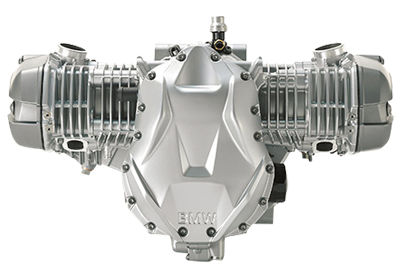
[MOTO GUZZI] Longitudinal V-twin
The V-twin since its debut in 1966 has been ripening and uses OHV even now as the main configuration (they also use SOHC).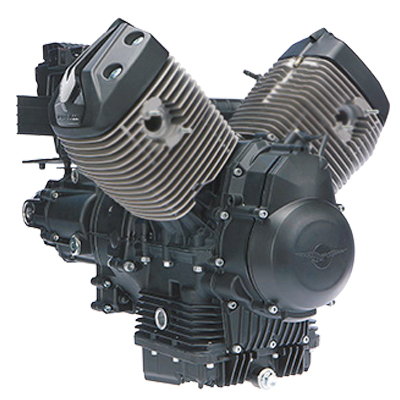
Looking back on the history of the motorcycle engine!
The impact of the in-line four-cylinder engine of Honda’s CB750Four
When unravelling the motorcycle engine history, there exist the epoch-making ones of excellent layouts and systems born around some periods before and after World War II. But, the indispensable one, if we talk on the present-day sportbike engines of large displacement, is ‘the in-line four-cylinder engine of CB750Four which Honda debuted in 1969.
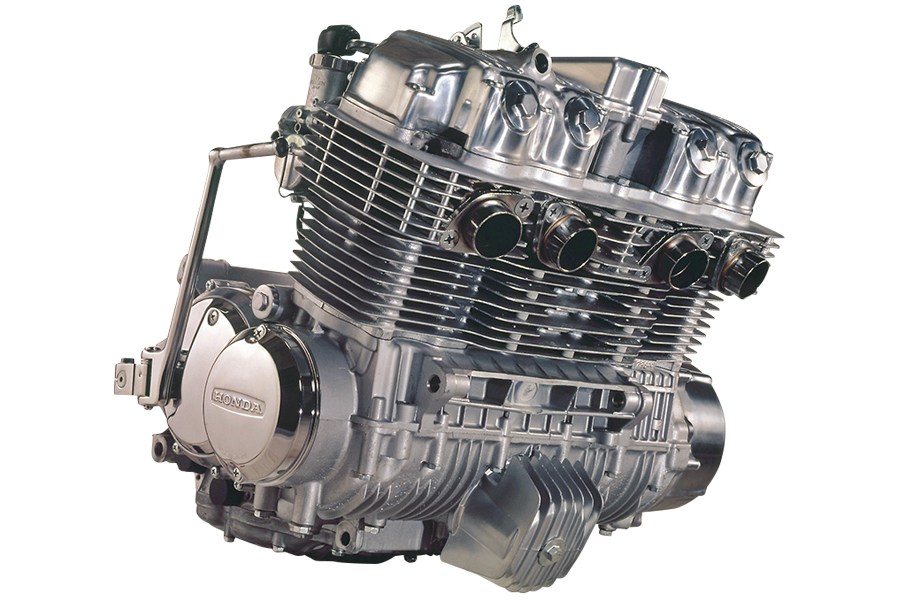
While many motorcycle manufacturers started with the two-stroke, Honda had been pouring their energies into the development of the four-stroke since its foundation. Then, the manufacturer challenged the Isle of Man TT in 1950’s and dominated WGP in 1960’s. The development experience in the racing machines may have been utilized, nonetheless the mass production of 750cc four-cylinder engine motorcycles was shocking in those days. Then, Honda completely drove out the famed British manufacturers after the release of CB750Four.

CB750Four is the first mass-produced consumer motorcycle in the world to be equipped with a in-line four-cylinder engine. It was exhibited in the 1968’s Tokyo Motor Show and an epoch-making model surprises motorcyclists all over the world.
Japanese-made four-cylinder engines dominated the motorcycle market
A new standard ‘big bikes are to be equipped with the four-cylinder engine’ was established by CB750Four, and Japanese competitors adapted to it. Kawasaki, which started to develop the four-cylinder engine earlier, put Z1 with DOHC into the market in 1972, while Suzuki put GS750 on sale and Yamaha debuted GX750 with three-cylinder DOHC in 1976 (XS1000 with four-cylinder DOHC on sale in 1977.) Honda countered the competitors by CB900/750F with four valves per a cylinder which it co-developed with a factory-backed endurance racing team.

In around 1980, there arouse an unprecedented motorcycle boom in Japan. Due to the structure of the domestic driver’s license, the mass of the domestic market bikes consisted of 400cc and 250cc, and the four-cylinder DOHC was put into those middle displacement motorbikes. It was a 400cc bike (Suzuki’s GSX400FW in 1983) that the water-cooled in-line four-cylinder engine was applied to, although that looks strange now. Then, the boom of ‘racer replica’ moved the middle displacement bike engines toward high performance radically in the mid-1980’s.
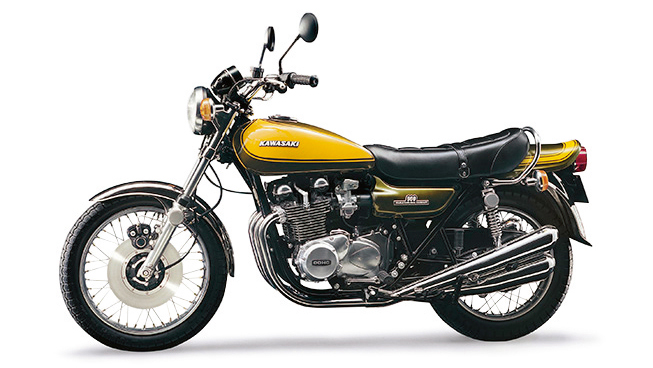
The bike is the first mass-produced consumer motorcycle to be equipped with DOHC four-cylinder engine. Due to the regulations implemented just before its release, the manufacturer produced its domestic model, 750cc Z2, in 1973.
The resurgence of two-stroke and its sudden fall after the triumph
When it comes to the replicas, we should talk on ‘two-stroke.’ In the first place, the other manufacturers than Honda put two-stroke onto their mainstream development, but the rise of large displacement bikes and the four-stroke forced the manufacturers to shift to the four-stroke, which made the two-stroke nearly extinct in the mid-1970’s. However, the appearance of Yamaha’s liquid-cooled RZ250 to which the manufacturer applied the technologies from its racer bike, TZ250, made the two-stroke resurge suddenly. Additionally, the motorcycle boom made the professional motorcycle racing such as WGP (now MotoGP) and All Japan Road Race Championship into a major entertainment, and that boosted the two-stroke’s popularity since GP machines used the same two-stroke.

TZR became the forerunner of the real two-stroke replicas. The motorbike series followed the racer bike, TZ250, evolutions going through the parallel two-cylinder, rear exhaust and V-shaped two-cylinder.
The two-stroke has a simple structure and is lighter, and the four-stroke has to rotate twice as many as the two-stroke to generate the same level of power in a simple comparison. So, it is reasonable that the two-stroke got the popularity in 250cc class, and the two-stroke was sufficiently comparable even with 400cc four-cylinder. Its engine intake system used piston reed valves, rotary disk valves in the same as the racer bikes, the crankcase reed valve system which is good in terms of fuel efficiency and handiness.
Also, the two-stroke’s engine characteristic ‘peaky and delicate, weak torque at low speed’ was addressed by the exhaust device ‘YPVS’ Yahama’s RZ250R (1983) was equipped with, and the competitors took similar systems. Then, after the mid-1980’s, there arose the two-stroke replicas like ‘a racer bike with safety features’ the manufacturers developed simultaneously with their racer bikes. These trends had gone on to the mid-1990’s the two-stroke declined due to the rise of emission control regulations and its lack of fuel efficiency.
Unexpectedly, no innovative engine technology was raised in 1990’s (of course, the existing technologies ripened and evolved though.) Among them, the eight-valve oval piston V4 engine in Honda’s NR750 debuted in 1992 attracted some motorcyclist attentions and exactly reflected feedbacks from racing technologies. Unfortunately, however, the nature of extremely high cost and race regulation change soon drove out the engine out of the spotlight.
Hectic chase by non-Japanese manufacturers pursuing for ease of riding
This article so far has dealt only with Japanese-made motorcycle engines, but how were non-Japanese manufacturers going? In fact, they didn’t make radical change of their engine layouts and structures in a short cycle, and they had stuck to their basic layouts before 1980’s. This sounds that they saw almost no evolution, but it is not true at all.
Ducati, based on their traditional air-cooled L-twin, debuted the liquid-cooled four-valve DOHC, 851, in 1988, BMW, who is seen to stick to the flat-twin, released K100 with the longitudinal liquid-cooled four-cylinder engine in 1983. The common and most noticeable thing in the two motorcycle models is the application of the fuel injection (FI) system. After that, Ducati and BMW have been ripening the FI technology, but somehow Japanese manufacturers got down to the use of FI finally in the late-1990’s.

‘Wizard’ Massimo Tamburini reformed the liquid-cooled four-valve 851 born in 1988 and produced 916 series. The narrow angle valve engine ‘Testastretta’ showed up in 2001’s 996 debut.
Up to the mid-2000’s, Japanese manufacturers had had clear advantages over non-Japanese ones in terms of supersport bikes, but non-Japanese supersport bikes made remarkable progress in early 2010’s. Their drastically reformed engines generated high performance comparable with Japanese four-cylinder engines, and beyond that they took the lead in the ‘handy’ electric controlling device technology.
Japanese manufacturers naturally tried to catch up. Starting with YZF-R1 in 2015, they consecutively put new models into the market. Motorcycle manufacturers pursued high rotation and output engines in the past, but they now go after handy and efficient engines. The competition for the quality of the engine control is likely to intensify further between advancing non-Japanese and glorious Japanese manufacturers. It deserves your attention.

The engine was consistent with the 2009’s cross-place parallel four-cylinder in concept, but drastically reformed. The motorcycle model was equipped with the engine of fully electric control mainly by IMU (inertial measurement unit, which measures the angular and acceleration rates of the motion’s three laws) and became the start of Japanese manufacturer’s counterattack against the foreign competitors.
What are the noticeable electric control systems of the next generation?

Riding mode
Using the riding mode, the maximum output, torque and throttle response can change, depending on driving scenes such as raining, sport, race etc. Some motorcycles have slick tire mode.
Traction control
The traction control detects the spins of rear wheels, reduces the torque by electric control throttle and fuel/ignition control and make the machine gain the traction efficiently. The driver can change the level of the stability control intervention and the system can be switched on/off.
Quickshifter
The quickshifter enables the driver to shift gears without using the clutch or throttle. With no interruption to the traction, the driver can shift gears when leaning at the start of a corner.
DCT (Dual-clutch transmission)
DCT is the system for multi-speed transmission which uses two separate clutches for odd and even gear sets. The driver can choose full automatic or semi-automatic transmission by clicking buttons.



